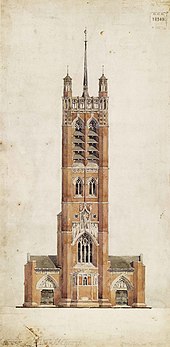William Bidlake

William Henry Bidlake (born May 12, 1861 in Wolverhampton , † April 6, 1938 in Wadhurst ) was an English architect , a leading head of the Arts and Crafts Movement in Birmingham and from 1919 to 1924 director of the School of Architecture at the Birmingham School of Art .
Several of Bidlake's houses in Birmingham were dealt with by Hermann Muthesius in his book The English House (1904) and thereby influenced the architecture of the beginning modernism in Germany.
Life
Bidlake was born the son of the architect George Bidlake. He received an education in architecture from his father and studied at Tettenhall College and Christ's College in Cambridge. In 1882 he moved to London , where he studied at the Royal Academy of Arts . He worked for the architects George Frederick Bodley and Thomas Garner , who cultivated the neo-Gothic style . In 1885 he won a travel grant from the Royal Institute of British Architects (RIBA) for his designs , which enabled him to travel through Italy in 1886.
When he returned to England in 1887, he settled in Birmingham , where he worked as a freelance architect. From 1893 on he taught innovative architecture at the Birmingham School of Art .
Bidlake designed many arts and crafts houses in affluent areas of Birmingham such as Edgbaston , Moseley and Four Oaks . His church buildings were more in the neo-Gothic style. The church of St Agatha’s in Sparkbrook is considered his masterpiece.
He was a member and treasurer of the Royal Birmingham Society of Artists and taught from 1902 to 1938 as a professor of architecture.
In 1924 Bidlake married a woman more than 20 years his junior and lived with her in Wadhurst , East Sussex , where he worked until his death.
Selected buildings
- College of Art, Balsall Heath, Birmingham (1899)
- Garth House, 47 Edgbaston Park Road, Edgbaston, Birmingham (1901)
- The Hurst , Amesbury Road, Moseley, Birmingham
- St Agatha's Church, Stratford Road, Sparkbrook, Birmingham (1901)
- Bishop Latimer Church, Winson Green, Birmingham
- St Agatha's Vicarage , 100 Sampson Road, Sparkbrook, Birmingham (1901)
- St Andrew's Church, Oxhill Road, Handsworth, Birmingham (1907-1909)
- St Mary's Church, Wythall, Worcestershire . Roof and tower
- St Oswald's Church, Small Heath, Birmingham (1892-09)
- St Thomas' Church, Stourbridge. Apse (1890)
- Sparkhill United Church, Stratford Road, Sparkbrook, Birmingham (1932-1933)
- Woodside , 51 Bracebridge Road, Four Oaks, Sutton Coldfield, Birmingham (1898), built for itself
- Woodgate , 37 Hartopp Road, Four Oaks, Sutton Coldfield, Birmingham (1900), built for itself
- Emmanuel Church, Wylde Green, Sutton Coldfield, Birmingham (1909)
literature
- Andy Foster: Pevsner Architectural Guides: Birmingham. Yale University Press: New Haven & London, 2005, ISBN 0-300-10731-5 .
- Alan Crawford (Ed.): By Hammer and Hand: The Arts and Crafts Movement in Birmingham. Birmingham Museums and Art Gallery, 1984, ISBN 0-7093-0119-7 .
- Trevor Mitchell: Birmingham's Victorian and Edwardian Architects. Phillada Ballard. ed. Oblong, 2009, ISBN 978-0-9556576-2-7 ( New Book celebrates Birmingham Victorian and Edwardian architects ).
Web links
Individual evidence
- ^ Bidlake, William Henry . In: John Archibald Venn (Ed.): Alumni Cantabrigienses . A Biographical List of All Known Students, Graduates and Holders of Office at the University of Cambridge, from the Earliest Times to 1900. Part 2: From 1752 to 1900 , Volume 1 : Abbey – Challis . Cambridge University Press, Cambridge 1940, pp. 259 ( venn.lib.cam.ac.uk Textarchiv - Internet Archive ).
- ^ A b William Henry Bidlake MA, FRIBA . In: Mapping the Practice and Profession of Sculpture in Britain and Ireland 1851-1951 . University of Glasgow. Retrieved September 14, 2013.
- ^ The Buildings of England: Worcestershire , Nikolaus Pevsner, 1968, p. 338.
- ^ The Buildings of England: Worcestershire. Nikolaus Pevsner, 1968, p. 268.
- ↑ Sparkhill United Church (Grade II) [1096067] ( English ) In: National Heritage List for England . Historic England . Retrieved November 2, 2014.
| personal data | |
|---|---|
| SURNAME | Bidlake, William |
| ALTERNATIVE NAMES | Bidlake, William Henry (full name) |
| BRIEF DESCRIPTION | English architect |
| DATE OF BIRTH | May 12, 1861 |
| PLACE OF BIRTH | Wolverhampton |
| DATE OF DEATH | April 6, 1938 |
| Place of death | Wadhurst |


